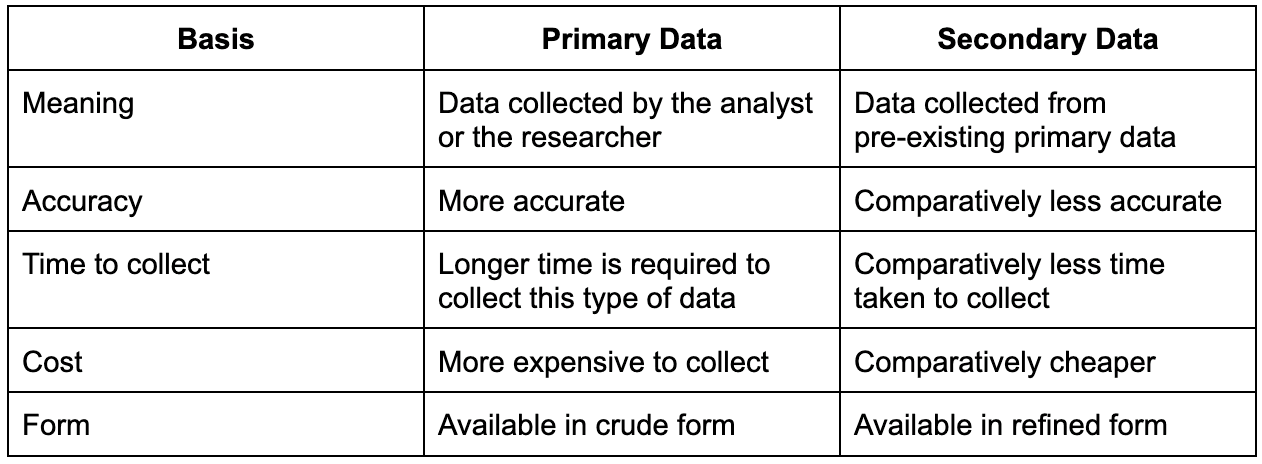What is Data Analysis?
30 May 2024

What is Data and What is Analysis
Let’s understand the term Data Analysis first. Data Analysis combines two words- Data and Analysis (as we can see).
Data is defined as collected observations or measurements represented as text, number or multimedia by the University of Houston. In the modern world, every action, every decision and every process generates data, even the non-digital ones. This generated data can be of three types- Primary, Secondary and Tertiary.
Primary Data
Benedictine University defines Primary data as the data that has been generated by the researchers themself by conducting surveys, interviews, questionnaires, observations and experiments. This type of data is directly collected from the users (or subjects in case of research). Primary data is specially designed for understanding and solving the problem at hand.
Secondary Data
Secondary data is the data collected from pre-existing data or the outputs of primary data. Generally secondary data is collected from reports, articles, statements, posts, journals or magazines. This list is not exhaustive and there can be other sources of secondary data as well. Secondary data is comparatively easier and faster to collect than primary data. However, primary data tends to be more detailed and accurate.
There are basic differences between primary and secondary data-

Tertiary Data
Tertiary data is the kind of data that is derived from Primary and Secondary data. It is practically a summary of the already existing primary and secondary data. It is not as detailed nor as accurate as primary and secondary data. Encyclopedias, Dictionaries, Facts, Blogs, etc. are some examples of tertiary data.
All types of data can be derived from multiple sources. Data sources are the location from where data originates. These sources can be broadly categorised into Internal and External sources of data. Understanding the sources of data is an essential task for any analyst as it helps identify the advantages and limitations of the data that has been collected.
Internal Data Sources
All the facts and figures that are derived from within the organisation are termed internal data. These are specific to the organisation. These can be collected from the organisational Departments, Reports, Employee and Customer Interviews, KPIs, etc. Internal data is mostly used to assess the effectiveness of the current business processes and policies. Even though internal data is very relevant to the organisation, it excludes the consideration of external factors that may affect the company immensely. Also, internal data is controllable by the organisation, and only authorised people can access it.
External Data Sources
All the facts and figures that are derived from outside the organisation and are open to the public are called external data. These can be government policies, financial trends, customer demographics, etc. This type of data is not specific to the organisation and affects other organisations as well, in varying degrees. External data determines the company’s situation and position in the market and is useful for conducting various kinds of analysis at the industry level. However, external data may or may not be completely relevant to the organisation in question and it is important to identify this. Also, external data cannot be controlled by the company in any way and is accessible by all.
Both Internal and External data are used by the analysts for their data analysis.
After understanding what data is in broad terms, we will now understand what is “Analysis”.
Merriam Webster Dictionary defines Analysis as a detailed examination of anything complex to understand its nature or to determine its essential features. Analysis is used in every field, be it research, medicine, technology, finance- you name it and analysis is a part of that field.
Analysis is also done in multiple ways, depending on what has to be derived from the analysis
What is Data Analysis
Data analysis is the process of collecting, cleaning, organising, analysing and visualising data to derive logical outputs from data. In simpler terms, it converts the data into information. Information is the data that is useful for the organisation. For example, “The global Big Data and Analytics market is worth $274 billion” is a data statement. Now for a company trying to enter the Big Data market, this will be information. Whereas for a local grocery store, it might just be data, that is of no use to the store.
Information is essential for an entity to adapt and grow in a fast-changing environment.
The goal of data analysis is to extract valuable insights from data and convert it into information that can be used to understand how it's affecting the company and make informed decisions based on this. Some examples of how data analysis can help businesses are listed below-
Businesses can optimise their performances to deliver better products and services
They can understand customer behaviour and make strategic decisions based on that.
Data Analysis can help a company identify trends in sales, understand the effectiveness of marketing campaigns and forecast future trends.
And many more….
Data Analysis requires various tools and techniques to be carried out, which we will understand in the later blogs.